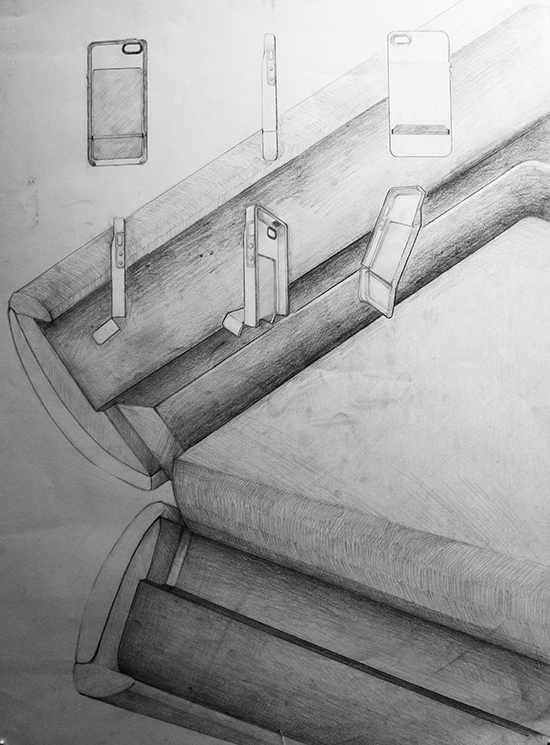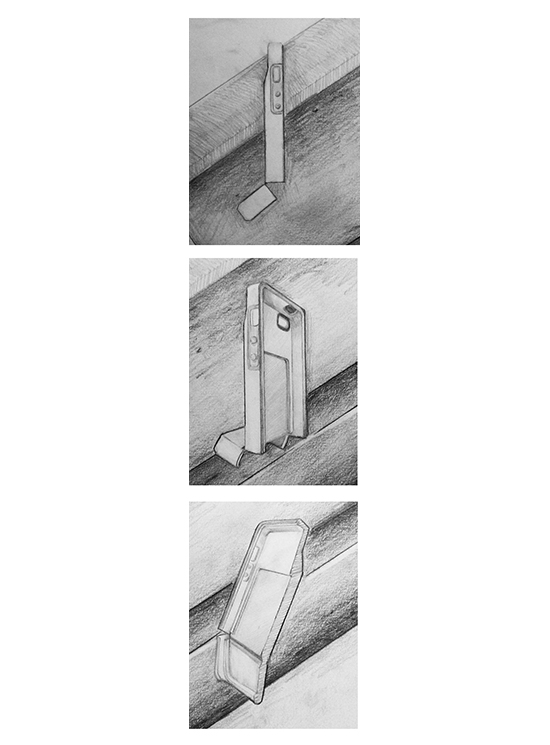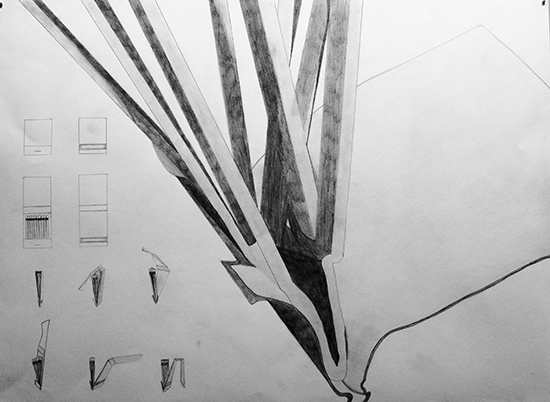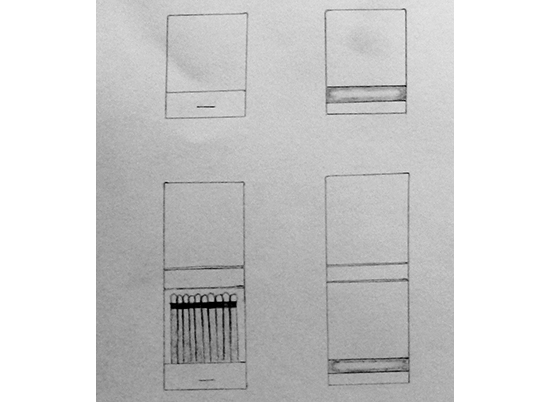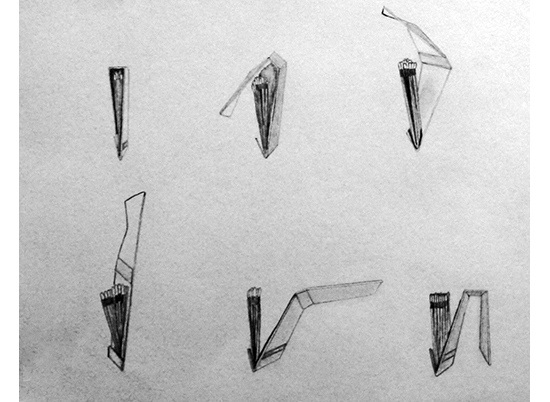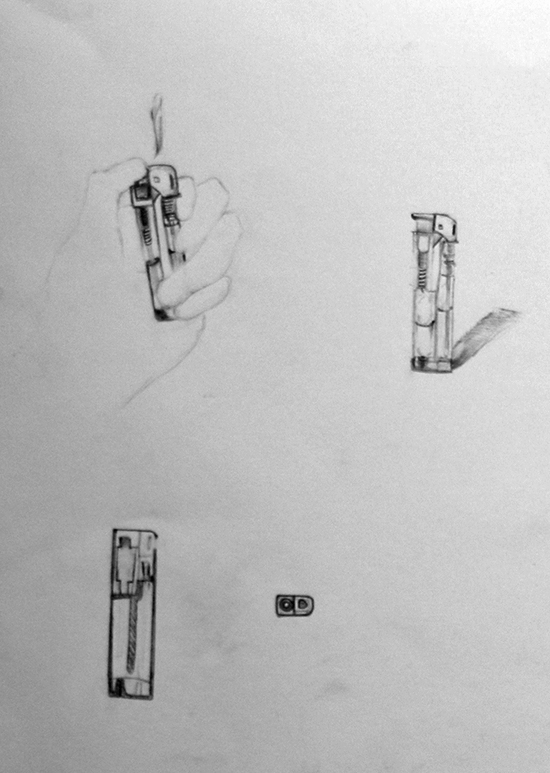How can empty space within an everyday object be represented visually? Three objects. Three approaches.
The Vessel Project
How do everyday objects incorporate empty space? And how can these empty spaces be represented visually? Three objects, and three approaches, come from Angela Bang, Annie Pluimer, and Honor Bishop.
Angela Bang: The Incipio® STASHBACK™ is a phone case produced by Incipio Technologies, meant to be an accessory compatible with the Apple iPhone 5s. What sets it apart from other standard phone cases is its additional feature— a carrying compartment for credit cards and cash. The bottom of the case works on a hinge mechanism, designed to be pried open with the user’s thumb, revealing the compartment. The case is actually two separate pieces of Plextonium, a proprietary material manufactured by Incipio Technologies, connected by a silicon lining. This feature contributes to the popularity of the case because it solves a problem, as well as addresses a need that users have. Because of how advanced and useful smartphones now are, most people keep their phones with them, often in the same location as their keys and wallet. The STASHBACK™ consolidates the function of the wallet and phone into one neat package. Instead of fumbling for their wallet in their pocket or bag, users need only to take out their phone. Paola Antonelli states in her book Humble Masterpieces: Everyday Marvels of Design, “Designers don’t really have solutions. They just walk along very human paths, trying to make things easier for other human beings.”1 A phone case that doubles as a wallet may not shake the world, but Antonelli doesn’t think it has to: “Design does not provoke revolutions, but when revolutions or major changes happen, design can help the world deal with them and transform them into positive change.”2
Annie Pluimer: Edgar Kaufmann Jr., director of the Museum of Modern Art’s (MoMA) 1950 Good Design exhibition, refers to good designed objects as objects in which “every detail contributes to the efficiency and at the same time to the fine appearance of the object.” 3 The simple folded design of the matchbook has gone through many different iterations since its introduction by Joshua Pusey in 1892. Charles Bowman patented his matchbook shortly after Pusey, and it is this design that remains the model for the matchbook seen today. Due to the consistency of the object’s design, it can then be said that the matchbook has “survived the test of time”—another distinguishing mark of good design—as the design proposed by Pusey and modified by Bowman continues to be produced. John McAndrew, curator of architecture at MoMA in 1937, refers to four important Bauhaus factors that determine modern form. The object in discussion keeps in line with these factors. One: “The form of the object is determined by its use.”4 The matchbook is used to produce a quick flame; it lights a candle, a cigarette, and is then disposed. The object’s design, therefore, does not require anything other than the two elements with which a spark is created and a protective shell for safety purposes; other materials or functionality are unnecessary. Two: “The form is also influenced by the material.”5 The majority of the object is composed of paperboard. This material provides a sturdy base upon which chemicals can sit and has a flexibility that enables the cover to move easily away from the strikers and back again without falling apart. Three: “The form is the result of some process of manufacture.”6 McAndrew writes that “the finished product will have the character of the process used in making it.”7 The precision of the manufacturing of the matchbook, as described above, is seen in the composition of the final object; the cuts and folds hint at machine use and do not suggest hand-crafted qualities. Four: “The finished form is the creation of the designer.”8 More than one hundred years later, the same model is used to produce the matchbook and produces the most perfect results for a cheap, efficient match device.
Honor Bishop: I was drawn to the translucence of the Poppell lighter because of the interesting conflict between the comprehensive functionality of the interior’s skeletal-like structure and the inability to fully gauge how each of the separate parts interact. Related to this is another aspect of the lighter’s interior that I hoped to catch in my sketches—the ambiguous nature of the differentiation between lighter fuel, plastic, and empty space within. I liked that the technology of the lighter seemed complex and disordered while retaining its functionality. The project was slightly alien to me, since I usually only sketch faces, and unlike the lighter, these are mostly abstract line drawings rather than realistic representations of a thing. I enjoyed the idea of exploring the space within the lighter that ‘didn’t exist’ through shading, and attempting to represent how scale is able to influence how one perceives an objects functionality as well as the complexity with which it performs a particular role.
- Antonelli, Paola, and Francesco Mosto. Humble Masterpieces: Everyday Marvels of Design, 4. New York, NY: ReganBooks, 2005.
- Ibid
- Kaufmann, Edgar Jr. “Good Design Need Not Be Costly.” The New York Times 3 Oct. 1948. Print.
- Lawrence, Sidney. “Declaration of Function: Documents from the Museum of Modern Art’s Design Crusade, 1933-1950.” Design Issues. Spring 1985: 65–77. Print.
- Ibid.
- Ibid.
- Ibid.
- Ibid.
